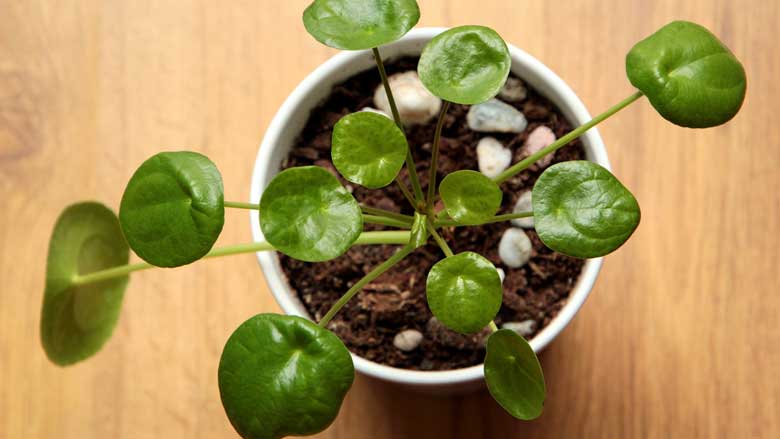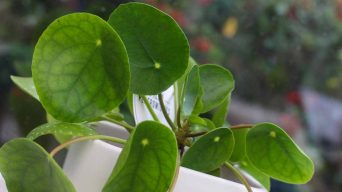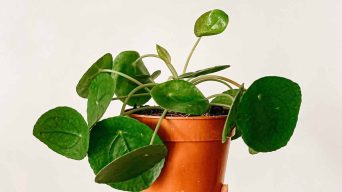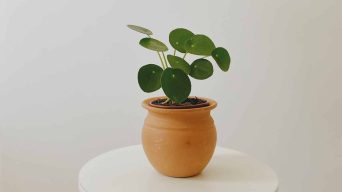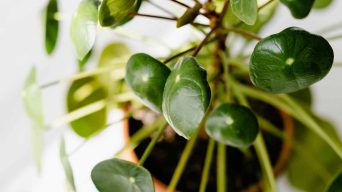Pilea leaves turn yellow mainly due to watering issues, poor lighting, temperature extremes, nutrient deficiencies, root rot, or pests. Fix by adjusting watering, ensuring proper light, maintaining stable temperatures, fertilizing, checking for root health, and treating pests as needed.
If you notice yellow leaves on your Pilea peperomioides, commonly known as the Chinese Money Plant, it’s natural to be concerned about its health.
Yellowing leaves are a frequent issue with these plants and can stem from various causes.
This discussion will explore the primary reasons behind this phenomenon and provide effective solutions to restore your plant’s vibrant green foliage.
Common Problems and Solutions for Yellow Pilea Leaves
Pilea plants, native to Southern China, have gained global popularity as houseplants due to their easy care and low maintenance requirements.
Like most plants, they can suffer without proper care despite their hardiness.
A frequent issue with Pilea plants is the yellowing foliage. This symptom, often seen in Chinese Money plants, can stem from various causes. Identifying the specific reason is crucial for implementing the right solution.
This article will explore the predominant causes of yellow leaves and provide effective solutions to address the issue.
1. Overwatering
Overwatering is a leading cause of yellow leaves in Pilea plants.
While these plants, native to tropical rainforests, thrive in high humidity and moist soil, excessive moisture can be detrimental.
Overly wet soil leads to leaves turning yellow and potential leaf drop. It also increases the risk of fungal infections, which can further harm the plant.
Addressing Overwatering
To remedy overwatering in your Chinese Money plant, let the soil dry out completely before the next watering.
Adjusting your watering routine is crucial; ensure the soil has time to dry between waterings.
A general rule is to water Pileas once a week or when the top inch of soil feels dry. Following these guidelines can prevent overwatering and maintain a healthy plant.
2. Underwatering
Underwatering can cause significant stress to Pilea plants, indicated by yellow foliage and wilting. This condition occurs when the plant can’t produce sufficient chlorophyll to maintain healthy leaves.
Other signs include wilting, dry soil, and brown leaf tips.
Low humidity, drafts, and poor soil drainage are common factors leading to underwatering.
Solutions for Underwatering
To remedy underwatering:
- Water the plant thoroughly. Afterward, regularly check the soil, ensuring it remains moist but not waterlogged.
- Modify your watering schedule to provide adequate hydration.
- A good indication of sufficient watering is if the soil stays moist (but not wet) for several days.
- Opt for less frequent but deeper watering sessions rather than frequent shallow watering. This approach promotes healthier plant growth.
You can effectively manage underwatering and keep your plant healthy by addressing these issues.
3. Poor Soil Drainage
Yellowing leaves in Pilea plants are often attributed to poor soil drainage, which can lead to root rot.
This occurs when roots remain excessively wet, hindering the efficient transport of water and nutrients and resulting in leaf discoloration and potential death.
Additionally, inadequate drainage may promote fungal growth, further harming the plant.
Solutions for Improved Drainage
To ensure the health of your Pilea, it’s crucial to use well-draining soil.
If drainage is an issue, consider amending the soil with perlite or sand to enhance its draining capability.
Another effective strategy is transplanting your Chinese Money Plant into a pot equipped with a drainage hole.
This allows excess water to escape, preventing waterlogging and associated root issues.
4. Poor Lighting
When Pilea’s leaves turn yellow, it often indicates insufficient lighting.
These plants thrive in bright, indirect light.
Without adequate light, they compensate by turning yellow, sometimes leading to dryness and brittleness.
Addressing Insufficient Lighting
To remedy this, relocate your Pilea to an area with brighter, indirect sunlight. Ideally, they should receive at least four hours of such light daily.
An east- or west-facing window is optimal for indoor Pileas.
If natural light is insufficient, consider using a grow light to meet the plant’s lighting needs.
5. Too Much Sun
Pilea plants are celebrated for their lush, green foliage.
Yet, exposure to excessive direct sunlight can cause their leaves to yellow.
This discoloration occurs as the intense sun degrades the chlorophyll, the pigment responsible for the plant’s green color.
Additionally, sunlight can harm the plant’s cell membranes, making the foliage dry and brittle.
Excessive Sunlight Corrective Measures
Should you notice yellowing in your Pilea plant, reposition it to an area with less direct sun.
Ideally, these plants thrive in bright but indirect sunlight.
If relocating the plant isn’t feasible, consider using sheer curtains or blinds to filter the sunlight, providing a more suitable light environment for the plant.
6. Temperature Extremes
Pilea, a tropical plant, thrives in stable temperatures, ideally between 68 and 72 degrees Fahrenheit.
Exposure to temperatures outside this range can cause its foliage to turn yellow.
If the temperature falls below 68 degrees, the plant will start yellowing; the same happens if it exceeds 72 degrees.
Despite this sensitivity, this houseplant is resilient and often recovers well from short periods of extreme temperature.
Managing Temperature Issues for Healthy Pilea
To maintain Pilea’s health, providing a consistent temperature environment is crucial. Here are some tips for doing so:
- In Cooler Temperatures: Gently warm your plant if it’s colder than 68 degrees. You can move it to a sunlit window or use a space heater to increase the room’s temperature.
- In Warmer Temperatures: Cooling your plant is key when it’s above 72 degrees. Consider placing it in a room with air conditioning or moving it outdoors to a shaded area.
By attentively managing the temperature, you can ensure the health and vibrancy of your plant.
7. Nutrient Deficiency
Pilea plants thrive on essential nutrients such as nitrogen, phosphorus, potassium, and magnesium.
These nutrients, typically absorbed from the soil, are crucial for their healthy and vibrant growth.
However, a nutrient deficiency can arise if the soil lacks these essential elements.
This deficiency can be due to overfertilization, under-fertilization, or inherently poor-quality soil.
Addressing Nutrient Deficiency
To remedy this, consider using a liquid fertilizer if your Pilea plant exhibits deficiency symptoms.
Dilute it to half its strength and apply it biweekly until the leaves regain their normal color.
Alternatively, the soil’s nutrient profile can be enhanced by incorporating organic materials like compost, manure, or worm castings, which benefit plants.
Additionally, repotting the plant annually with fresh, nutrient-rich soil can significantly boost its health and growth.
8. Root Rot
Pilea plants are susceptible to root rot, a fungal disease that can kill the plant.
Root rot is caused by several fungi and typically attacks the plant’s roots.
These fungi are most often found in wet, poorly drained soil.
This prevents the roots from getting the oxygen they need, which causes them to break down and die.
As the roots die, they can no longer take up water and nutrients from the soil, causing the leaves to turn yellow and eventually die.
Addressing Rotting
If you suspect root rot in your Pilea, examine the roots for fungal indicators. Telltale signs include black, soft, and slimy roots.
To rescue the plant:
- Remove it from its pot and gently rinse the roots with water.
- After washing, dry the roots thoroughly.
- Repot the plant in fresh, well-draining soil.
- Consider applying a fungicide to eradicate the fungus.
Prompt action is crucial to save an affected plant from root rot.
9. Pests
Pilea plants, including the popular Chinese Money plant, are vulnerable to pests such as aphids, mealybugs, and spider mites.
These pests can cause the leaves to turn yellow through various means.
They might deplete the plant nutrients by sucking out the sap or physically damaging them, leading to yellowing and eventual death.
Additionally, pests can transmit diseases to other plants, causing leaf discoloration.
Remedies for Pest Infestations
If your Pilea plant is infested, consider using neem oil or insecticidal soap.
Neem oil, extracted from the neem tree, is an effective natural pesticide against various pests. Insecticidal soap, another natural option, eliminates pests by suffocating them.
Alternatively, you can manually remove pests using a spray bottle or a specialized horticultural toothbrush.
These methods provide an eco-friendly way to protect your plant and restore its health.
10. Diseases
Pilea plants are prone to diseases like botrytis blight, leaf spot, and powdery mildew.
These conditions often lead to yellowing of the leaves, which may rot, die, or develop a white powdery coating.
Addressing Pilea’s Health
Prompt action is crucial when your plant shows disease symptoms.
Start by removing and disposing of any affected leaves.
Then, treat the plant with an appropriate fungicide or pesticide, following the product’s instructions strictly.
In cases of severe infection, discarding the affected plant and replacing it with a new one might be necessary.
Yellowing Bottom Leaves
Pilea plants are known for their vibrant, green leaves.
However, sometimes, a plant’s bottom leaves will turn yellow.
There are a few possible reasons for this.
One possibility is that the plant is not getting enough light.
Pilea plants need bright, indirect light to stay healthy.
If the bottom leaves turn yellow, it may be a sign that the plant is not getting enough light.
Another possibility is that the plant is getting too much water. They like to stay moist but not wet.
Overwatering can cause the bottom leaves to fall off.
Pilea’s Leaves Turning Yellow and Falling Off
Yellow falling leaves in Pilea plants are frequently linked to watering issues.
They thrive in moist but not waterlogged soil. If the soil becomes too dry, the leaves can turn yellow and fall off.
Conversely, overly wet soil can lead to root suffocation, causing a similar yellowing and shedding of leaves.
Yellow and Brown Coloration
Yellowing and browning of leaves is a frequent issue in Pilea plants. This condition can arise from various factors, such as excessive sunlight, inadequate water, or a lack of nutrients.
If you notice a slight yellow tint on the leaves, it often indicates that the plant needs more water. Therefore, increasing the watering frequency might help.
On the other hand, if the leaves have turned completely yellow and brown, it suggests a more serious problem, such as root rot.
Root rot, often caused by overwatering or substandard soil, leads to yellow and brown leaves and can cause the plant to wilt. In case of root rot, immediate attention is required to save the plant.
Yellow and Black Discoloration
Overwatering is one of the most common reasons Pilea leaves turn yellow and black.
Pileas like to be kept moist but not soggy.
If your Pilea is sitting in water or its pot doesn’t have adequate drainage, this could cause the roots to rot and the leaves to turn yellow and black.
Another possibility is that the plant is experiencing spider mites.
Spider mites are tiny, red bugs that can cause the leaves of a plant to turn yellow and black.
They can be difficult to eliminate, so it’s best to take action as soon as you notice them.
Should Yellow Leaves Be Removed?
Pilea plants (Chinese money plants) are beautiful, easy-to-care-for houseplants popular for their round, green leaves.
However, many Pilea owners become concerned when they notice yellow leaves on their plants.
So, should you remove yellow leaves from a Pilea plant?
The answer to this question depends on the cause of the yellow leaves.
If the leaves turn yellow due to overwatering, remove them, as they will not recover.
However, removing leaves may do more harm than good if the leaves turn yellow due to a lack of water or nutrients.
The best way to determine why your leaves turn yellow is to inspect the root system.
If the roots are healthy and white, the plant will likely get enough water and nutrients.
However, if the roots are brown or black, the plant is not getting enough of either.
You can add a water-soluble fertilizer to your watering routine or transplant the plant to a pot with fresh soil.
No matter the cause of the Chinese Money plant yellow leaves, it is essential to keep an eye on the plant’s overall health.
If most leaves turn yellow, the plant is likely unhappy and needs your help.
Try adjusting your watering schedule or fertilizing routine, and keep an eye on the plant to see if its condition improves.
It may be time to consider replacing the plant if it doesn’t.
Final Thoughts
Pilea plants (Chinese money plants) are easy-to-care-for houseplants popular for their round, green leaves.
However, if your Pilea leaves start to turn yellow, there could be a problem with their plant care routine.
The most important thing to do is identify the cause of the yellowing leaf so you can take steps to correct it.
But don’t worry; in most cases, the solution is relatively easy, and your Pilea will be back to its former glory in no time.

